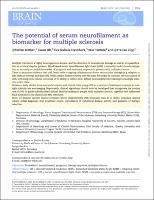| dc.contributor | Vall d'Hebron Barcelona Hospital Campus |
| dc.contributor.author | Bittner, Stefan |
| dc.contributor.author | Tintore, Mar |
| dc.contributor.author | Zipp, Frauke |
| dc.contributor.author | Oh, Jiwon |
| dc.contributor.author | Kubala Havrdova, Eva |
| dc.date.accessioned | 2022-06-07T12:16:35Z |
| dc.date.available | 2022-06-07T12:16:35Z |
| dc.date.issued | 2021-10 |
| dc.identifier.citation | Bittner S, Oh J, Kubala Havrdová E, Tintoré M, Zipp F. The potential of serum neurofilament as biomarker for multiple sclerosis. Brain. 2021 Oct;144(10):2954–63. |
| dc.identifier.issn | 1460-2156 |
| dc.identifier.uri | https://hdl.handle.net/11351/7631 |
| dc.description | Biomarkers; Neurofilament; Therapy response |
| dc.description.abstract | Multiple sclerosis is a highly heterogeneous disease, and the detection of neuroaxonal damage as well as its quantification is a critical step for patients. Blood-based serum neurofilament light chain (sNfL) is currently under close investigation as an easily accessible biomarker of prognosis and treatment response in patients with multiple sclerosis. There is abundant evidence that sNfL levels reflect ongoing inflammatory-driven neuroaxonal damage (e.g. relapses or MRI disease activity) and that sNfL levels predict disease activity over the next few years. In contrast, the association of sNfL with long-term clinical outcomes or its ability to reflect slow, diffuse neurodegenerative damage in multiple sclerosis is less clear. However, early results from real-world cohorts and clinical trials using sNfL as a marker of treatment response in multiple sclerosis are encouraging. Importantly, clinical algorithms should now be developed that incorporate the routine use of sNfL to guide individualized clinical decision-making in people with multiple sclerosis, together with additional fluid biomarkers and clinical and MRI measures. Here, we propose specific clinical scenarios where implementing sNfL measures may be of utility, including, among others: initial diagnosis, first treatment choice, surveillance of subclinical disease activity and guidance of therapy selection. |
| dc.language.iso | eng |
| dc.publisher | Oxford University Press |
| dc.relation.ispartofseries | Brain;144(10) |
| dc.rights | Attribution-NonCommercial 4.0 International |
| dc.rights.uri | http://creativecommons.org/licenses/by-nc/4.0/ |
| dc.source | Scientia |
| dc.subject | Esclerosi múltiple - Imatgeria per ressonància magnètica |
| dc.subject | Filaments citoplasmàtics |
| dc.subject | Esclerosi múltiple - Prognosi |
| dc.subject.mesh | Neurofilament Proteins |
| dc.subject.mesh | Multiple Sclerosis |
| dc.subject.mesh | /diagnostic imaging |
| dc.subject.mesh | Prognosis |
| dc.title | The potential of serum neurofilament as biomarker for multiple sclerosis |
| dc.type | info:eu-repo/semantics/article |
| dc.identifier.doi | 10.1093/brain/awab241 |
| dc.subject.decs | proteínas de neurofilamentos |
| dc.subject.decs | esclerosis múltiple |
| dc.subject.decs | /diagnóstico por imagen |
| dc.subject.decs | pronóstico |
| dc.relation.publishversion | https://doi.org/10.1093/brain/awab241 |
| dc.type.version | info:eu-repo/semantics/publishedVersion |
| dc.audience | Professionals |
| dc.contributor.organismes | Institut Català de la Salut |
| dc.contributor.authoraffiliation | [Bittner S, Zipp F] Department of Neurology, Focus Program Translational Neuroscience (FTN) and Immunotherapy (FZI), Rhine-Main Neuroscience Network (rmn2), University Medical Center of the Johannes Gutenberg University Mainz, Mainz 55131, Germany. [Oh J] Division of Neurology, Department of Medicine, St Michael’s Hospital, University of Toronto, Toronto, Ontario M5S 3H2, Canada. [Kubala Havrdová E] Department of Neurology and Center of Clinical Neuroscience, First Faculty of Medicine, Charles University and General University Hospital, Prague 116 36, Czech Republic. [Tintoré M] Servei de Neurologia, Vall d’Hebron Hospital Universitari, Barcelona, Spain. Centre d’Esclerosi Múltiple de Catalunya (CEMCAT), Barcelona, Spain |
| dc.identifier.pmid | 34180982 |
| dc.identifier.wos | 000733375400012 |
| dc.rights.accessrights | info:eu-repo/semantics/openAccess |

 Private area
Private area Contact Us
Contact Us







